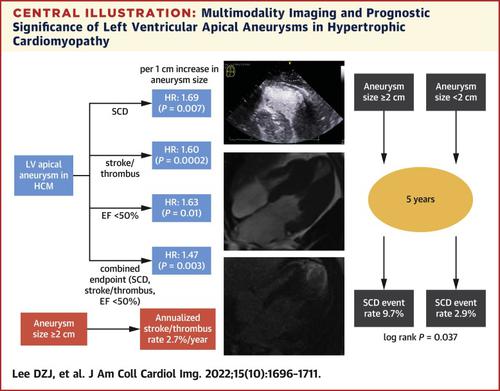JACC: Cardiovascular Imaging ( IF 12.8 ) Pub Date : 2022-06-15 , DOI: 10.1016/j.jcmg.2022.03.029 Deacon Z J Lee 1 , Mahdi Montazeri 1 , Roxana Bataiosu 1 , Sara Hoss 1 , Arnon Adler 1 , Elsie T Nguyen 2 , Harry Rakowski 1 , Raymond H Chan 1

|
Background
Left ventricular (LV) apical aneurysms in hypertrophic cardiomyopathy (HCM) are a recognized risk marker for adverse cardiovascular events. There is variable practice among clinicians and discordance between international guidelines regarding treatment recommendations and prognostication for this important phenotype.
Objectives
The authors sought to describe the morphology, clinical course, and risk of adverse events in a large single-center cohort of HCM patients with LV apical aneurysms.
Methods
This study analyzed 160 HCM patients with an LV apical aneurysm who were evaluated in our dedicated HCM clinic between January 1997 and April 2021.
Results
Mean age was 59.1 ± 13.6 years, and 71% of these patients were male. Mean aneurysm size was 1.77 ± 1.04 cm. Over 6.2 ± 4.8 years, 14 (9%) patients had a sudden cardiac death (SCD) event, including appropriate therapy from an implantable cardioverter-defibrillator (ICD) or resuscitation from cardiac arrest (annualized event rate 1.77%/y), 39 (24%) had either a thromboembolic stroke or apical thrombus formation (2.9%/y), and 14 (9%) developed LV systolic dysfunction with an ejection fraction (EF) <50% (1.28%/y). HRs for SCD, stroke or thrombus, and EF <50% per 1-cm increase in aneurysm size were 1.69 (P = 0.007), 1.60 (P = 0.0002), and 1.63 (P = 0.01), respectively. Aneurysm size ≥2 cm was associated with a 5-year SCD rate of 9.7%, compared with 2.9% for aneurysm size <2 cm (log-rank P = 0.037). This subgroup also had higher risk of stroke/thrombus formation (HR: 2.20; P = 0.002), with an annualized event rate of 2.7%/year. A total of 39 (24%) patients reached the combined end point of SCD, stroke, or LV dysfunction (2.12%/y) with an HR of 1.47/cm increase in aneurysm size (P = 0.003) and an HR of 2.22 for patients with aneurysm size ≥2 cm (P = 0.02).
Conclusions
Increasing aneurysm size confers poorer prognosis. Aneurysm size ≥2 cm should alert potential consideration for prophylactic anticoagulation and primary prevention ICDs.
中文翻译:

肥厚型心肌病左心室顶端动脉瘤的临床特征及预后意义
背景
肥厚型心肌病 (HCM) 中的左心室 (LV) 心尖动脉瘤是公认的不良心血管事件的风险标志物。临床医生之间的实践各不相同,国际指南之间关于治疗建议和这一重要表型预后的不一致。
目标
作者试图描述一个大型单中心 HCM 患者的 LV 心尖动脉瘤患者队列中的形态、临床过程和不良事件风险。
方法
本研究分析了 1997 年 1 月至 2021 年 4 月期间在我们专门的 HCM 诊所接受评估的 160 名患有 LV 心尖动脉瘤的 HCM 患者。
结果
平均年龄为 59.1 ± 13.6 岁,其中 71% 的患者为男性。平均动脉瘤大小为 1.77 ± 1.04 cm。在 6.2 ± 4.8 年期间,14 名 (9%) 患者发生心源性猝死 (SCD) 事件,包括通过植入式心脏复律除颤器 (ICD) 进行适当治疗或心脏骤停复苏(年化事件发生率为 1.77%/年),39 (24%) 有血栓栓塞性卒中或心尖血栓形成 (2.9%/y),14 (9%) 人出现左室收缩功能障碍,射血分数 (EF) <50% (1.28%/y)。SCD、中风或血栓的 HR 和 EF <50% 的动脉瘤大小每增加 1 厘米分别为 1.69 (P = 0.007)、1.60 (P = 0.0002) 和 1.63 (P =0.01),分别。动脉瘤大小≥2 cm 的 5 年 SCD 发生率为 9.7%,而动脉瘤大小 <2 cm 的发生率为 2.9%(对数秩P = 0.037)。该亚组的卒中/血栓形成风险也较高(HR:2.20;P = 0.002),年化事件发生率为 2.7%/年。共有 39 名 (24%) 患者达到了 SCD、卒中或 LV 功能障碍的综合终点 (2.12%/y),动脉瘤大小的 HR 增加 1.47/cm (P = 0.003),HR 为 2.22动脉瘤大小≥2 cm 的患者(P = 0.02)。
结论
动脉瘤大小增加导致预后较差。动脉瘤大小≥2 cm 应提醒潜在的考虑预防性抗凝和一级预防 ICD。











































 京公网安备 11010802027423号
京公网安备 11010802027423号